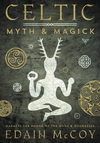Ireland’s Sacred Wells

Ireland is a magical place.
I don't mean this in the way guidebooks do when they promise travelers an idyllic vacation, one full of hikes in shockingly green valleys; evenings in music-, dance-, and ale-filled pubs; and encounters with gracious, ebullient people. Of course, travelers to Ireland will find these pleasures, but this is not what I mean when I say that Ireland is a magical place.
And I don't mean that the fairies and giants, the talking greyhounds and the enchanted eagles that fill Irish folk tales actually exist … though the lush glens around Kenmare or the bald mountains of County Kerry would be just the places to find such wonderful creatures.
Nor do I merely mean that Ireland—like other countries influenced by the ancient Celtic people—has a history rich in Druidic and pagan spirituality, a history in which rituals marking birth and death, transformation and restoration, sustained generations. This approaches what I have in mind, however. For Ireland's spiritual history is a living history. Scholars, writers, storytellers, and spiritual practitioners bring these rituals and beliefs to life for people around the world. Part of Ireland's magic consists, then, in the continued, vibrant connection between the spiritual beliefs of its people, past and present.
But I mean more than this. When I say that Ireland is a magical place, I mean that the land itself helps make this connection possible. For thousands of years, the inhabitants of Ireland have turned toward the earth to find outlets for spiritual expression. They have looked earthward to gain not only physical but also spiritual sustenance and rejuvenation. In return, the earth has offered what it continues to offer today, namely the elements, physical and metaphysical, necessary for cycles of growth, decay, and new growth. In this sense, there are no parts of Ireland more magical than its sacred wells.
Driving slowly on a road only as wide as a cow path, I had no idea that the walled field to my right contained anything but rain-drenched grass, though a small handmade sign indicated the presence of an ancient monastic site. Pulling over as best I could, I parked, squeezed between fence posts, and made my way towards some bramble- and grass-covered mounds. Clearly, this was an unexcavated site, and an uninspiring one at that. There were only a few grey, lichen-encrusted stones visible, and it was impossible to determine just what kind of buildings these stones once supported.
Turning to leave, I saw, some yards away, another circular-shaped mound, and decided to take the brief detour on my way back to the car. Just as in the adjacent area, a tangle of long grass and low branches covered what could have been boundary walls, or the foundation of a small building; it was too hard to tell. Here, however, something bright flashed in the grass, something like a mirror or a pane of glass, flush with the ground.
Crouching down, I saw the sky's low-hanging clouds reflected in a round pool of water about a foot in diameter and framed by a flat, hewn rock. At first I thought this was some kind of sunken basin, full of accumulated rainwater. After taking a closer look, though, I saw slight ripples in the water: this was a well, apparently fed from an underground stream. And glinting up from the bottom, among dark rocks and pale gravel, were bright, copper-colored coins.
I had come across one of literally thousands of wells scattered across Ireland, and the coins provided evidence that others had as well, either deliberately, or, as in my case, by chance. Had hikers left the coins in exchange for a cool drink? Had children tossed them in for luck? Had a neighbor left them to secure the outcome of a wish, or perhaps a prayer? Had a pilgrim left them as an offering to a local saint as thanks for divine intercession? If any of these possibilities were true, then people were using this well as had generations of local inhabitants. Likely, to those who return to this well for refreshment of body or soul, it is considered sacred, despite its now obscure and obscured location.
This well, unidentifiable to passing strangers like me but probably known to locals as associated with a particular Christian saint—perhaps one of the members of the ancient monastic community—is almost certainly much older than the ruins currently surrounding it. Further east and along the southern coast of Ireland, on a gently sloping ridge overlooking the sea, one finds a similar spring adjacent to the Stone Age Drombeg Circle.
Referred to by locals as the Druid's Altar, this impressive collection of 13 surviving standing stones—built, given its orientation, to celebrate the winter solstice—abuts the remains of two small huts. Here, one finds a Neolithic kitchen site comprised of a stone cooking-pit next to an opening leading to an underground stream. Archeologists surmise that, given such evidence of ancient "accommodations," Drombeg Circle was a place of regular ritualistic gathering. This water source, then, was probably used both for sacred rites and to meet the more mundane needs of those who gathered there, until the 5th century CE, to witness the winter solstice sunset.
Was the small, unnamed well that I stumbled across similarly associated with pre-Christian ritual? Excavation might help answer this question, since other wells and springs, long since Christianized, have yielded pre-Christian artifacts. In fact, it's often unnecessary to dig in order to find evidence of pre-Christian influence at sacred wells. Consider, for example, St. Brendan's Well, a small stone-framed underground spring remarkably similar to my obscure, grass-covered well. Located in the important 12th century monastic center of Cill Maolchéadair on the Dingle Peninsula, the well is neighbor to what's taken to be an ancient sundial. A local guidebook recounts that this stone had probably been recycled, even in the 12th century; quite likely it once functioned as part of an ancient fertility rite. Another nearby well dedicated to St. Brendan tops the peak of Mount Brandon, a location where Iron Age people celebrated the beginning of the harvest, the Celtic fire festival of Lughnasa. The well and its accompanying pillar stone are thought to pre-date the 5th century Christian saint who, in late June, is still venerated here.
Still other Christianized wells are located at sites long associated with ancient kingship ritual, including the Doon Well in County Donegal. Many of these thousands of wells are situated geographically—by a rocky outcrop, on a mountain side, or where fresh water mixes with the sea—in a way that has profound resonance with aspects of ancient Irish mythology and the Irish Celtic tradition of locating cosmic power within the earth. Furthermore, many are still found in close proximity to a tree, often a hawthorne, whitethorne, or ash, or perhaps a rowan, oak, holly, or hazel. These trees are all part of the Celtic tree calendar. Furthermore, they play significant roles in Irish Celtic myths in which certain trees possess or confer specific magical or healing properties, such as the power of divination, protection from storms, or the guarding of the sacred gateway into the underground Otherworld.
A further indication of the spiritual continuity that wells facilitate are the numerous wells across the countryside dedicated to St. Brigid, a figure from early Irish Christian history who likely never actually lived. Associated with agriculture, especially cows, St. Brigid has her feast day on February 1—a day that is also known as Imbolc and is associated with the Celtic fire goddess Brigid. Historians commonly agree that the goddess Brigid became St. Brigid as Christianity swept across Ireland. Archeologists indicate that some of the wells dedicated to St. Brigid are Celtic in origin and were once sites of fertility rites or other kinds of pagan rituals.
This sort of evidence aside, perhaps the strongest evidence that the wells and fresh water springs of Ireland unite the spirituality of its ancient and modern people are the practices still carried out by those visiting the wells. On holy days—typically the feast day of the saint associated with the well or the local parish—pilgrims circumambulate clockwise, or do a set number of "patterns," around the well while reciting particular prayers. Often the pattern requires walking around a holy tree or a sacred stone, or in and around other features of the site, such as a hill, stream, or cave.
The patterns at some wells include pilgrims kissing, rubbing, scratching, or marking stones located at the site; lying on or passing their bodies through specific features of the site; and bathing in and drinking the water. Pilgrims often add small stones to piles left by others, or they leave behind coins, holy metals, pictures, written prayers, pins, crosses, keys, rosaries, or statues as they finish their visits. At sites with holy trees, pilgrims often tie white or red pieces of cloth, or pieces of clothing such as scarves, baby bibs, or gloves, to branches. An accompanying prayer might implore that, as the cloth disintegrates, the ailment afflicting the person in whose name the cloth is left, and whom the cloth once touched, diminish as well.
This final practice of leaving behind votive offerings is nowhere more evident than at St. Brigid's Well in Liscannor, County Clare. Enclosed in a small, narrow, low-ceilinged building with a single, gently curving interior passageway, this well is situated on the side of a tree-covered rise near Liscannor Bay. A freshwater stream emerges from the hill, and is caught in a stone basin at the very end of the curved passage in the interior of the dark, damp structure; a cup hangs on a chain in the basin for pilgrims to use to drink the cold, clear water. Lining the walls are hundreds of objects left by pilgrims: photographs, votive candles, prayer cards, statues, letters, rosaries, crutches and prosthetics, clothing, books, children's toys, saint's medals, hand-written prayers, and countless other personal belongings. The damp has caused many of the objects to molder, leaving the visitor with a haunting and sobering visual impression of the grief and hope expressed in this space.
The general features of such behaviors at holy wells—such as the veneration of stones, living trees, and small hills; the drinking of water; or the leaving behind of red clothes thought to ward off evil—are clearly incorporated into an explicitly Catholic religious context. However, they do not necessarily reflect specifically Christian practices. Yet they do resonate with features of Irish Celtic mythology and, hence, quite likely reflect ritualistic practices of the early Irish people. In this ancient Celtic context, small hills were associated with the fertile swelling of the goddess, and breaks in the walls of mountains were regarded as doors to the Otherworld. Trees, such as the hazel, were thought to contain feminine wisdom and a branch of the hazel, according to legend, was made into a wand for the earthly king as a sign of authority granted by the goddess. Wells and streams were regarded as the symbolic meeting place, often the wedding site, of the earthly king or chieftain and the otherworldly goddess. Drinking water from such a sacred spring was thought to confer the wisdom of the goddess to the drinker and, when the goddess was thought to be the spring itself, symbolized a union of the spiritual and the physical worlds. It is not difficult to recognize the traces of these ancient beliefs in the practices of present day pilgrims and other visitors to Ireland's sacred wells.
When I cupped my hands and drank from the small well I discovered by chance in an empty green pasture on Ireland's west coast, I did not fully realize the spiritual legacy in which I was taking part. Countless hands had dipped into the very same water, countless supplications had been whispered there, and countless footsteps led away from the ancient spring. Like others before me, I left the well refreshed, having been renewed by the power of the land, grateful for having tasted the magic of Ireland.
References
Conway, D. J. Celtic Magic. St. Paul, MN: Llewellyn Worldwide, 1994.
Brenneman, Walter L., Jr. and Mary G. Brenneman. Crossing the Circle at the Holy Wells of Ireland. Charlottesville, VA: University Press of Virginia, 1995.
Logan, Patrick. The Holy Wells of Ireland. London: Colin Smyth Limited, 1980.
Related Products



is subject to certain Terms and Conditions